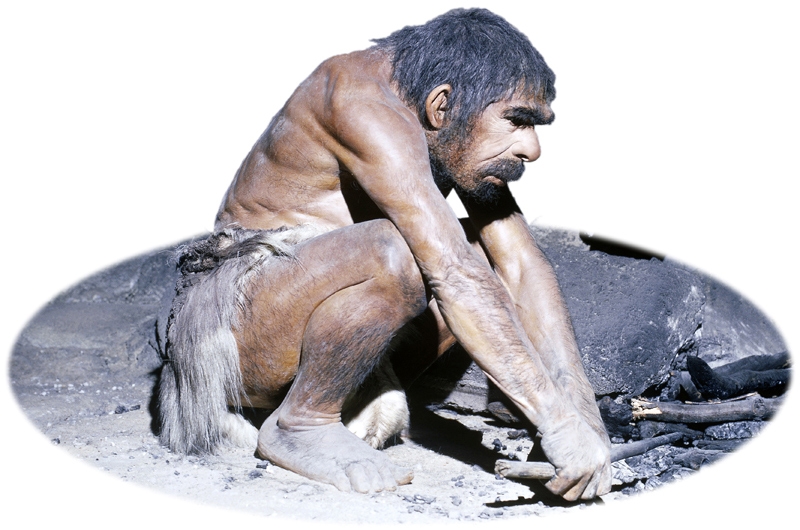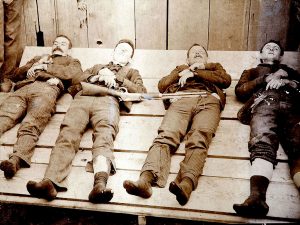The human species that today makes astounding advances in technology, and particularly in the medical field, did not exist four million years ago. In fact, hominids of that period were very different from the modern species in many ways. How did humans evolve to become today’s humans? How did Homo sapiens become so innovative? For one, they developed favorable qualities that were essential for adaptation and a thriving existence.

Homo sapiens derived from a form of early humans called Neanderthal. Unlike modern humans, characteristics of the Neanderthal included occipital buns and protruded brow ridges.1 One important facial feature of the Neanderthal was their large nose for “humidifying and warming cold, dry air” before it reached the lungs.2 Modern humans do not have this characteristic due to the fact that the Neanderthals lived in much harsher conditions. Thanks to the work of archaeologists and anthropologists, we know a great deal about the life and world of Neanderthals. The first fossils of these humans were found in France, and scholars have since called these humans Cro-Magnon. They created innovative tools from bones and antlers for hunting. This enabled them to survive and thrive in their environment. They even created artwork “in the form of decorated tools, beads, ivory carvings of humans and animals, clay figurines, musical instruments, and cave paintings.”3

Homo sapiens originated from East Africa. From there homo sapiens have migrated to all of earth’s main land masses. By taking advantage of land bridges, they have spread to Indonesia, New Guinea, Australia, and the Americas. Another contributing factor to the spreading of humans was the recent major Ice Age. The freezing of the oceans’ waters around the polar caps lowered the sea level, which exposed land bridges between land masses that were otherwise under water. For example, the connection between Calabria and Sicily had a sea level around -126 meters.4 They were able to adapt to the different environments due to their larger brain capacities, hence more intelligence. Having the knowledge that they had, they were able to create warm clothes and shelters to survive under various harsh conditions in the regions they occupied. Since they were nomadic people, there was no economic prosperity during the Paleolithic era. This was due to the fact that they never inhabited an area for a long duration of time. They were foragers; they scrapped up whatever they could find for survival, so there was no time period in which they could accumulate wealth. With that being said, that meant that there were no social classes. Instead, they lived an egalitarian lifestyle. While the men hunted, the women gathered. This method sustained their existence until the Neolithic Revolution, which domesticated both plants and animals.
The evolution of earlier hominids to Homo sapiens opened the door to a species capable of more advanced thinking about their surroundings and survival. The human race has since continued to thrive to the present. Without their innovative tools, body structures, and eventually domestication of plants and animals, Homo sapiens would not have been able to produce the advancements in technology and sciences that we have available today.
- Markus Bastir, Paul O’Higgins, and Antonio Rosas, “Facial Ontogeny in Neanderthals and Modern Humans,” Proceedings of the Royal Society B: Biological Sciences 274, no. 1614 (May 7, 2007): 1125–32. ↵
- Todd C. Rae, Thomas Koppe, and Chris B. Stringer, “The Neanderthal Face Is Not Cold Adapted,” Journal of Human Evolution 60, no. 2 (February 2011): 234–239. ↵
- “Evolution: Humans: Origins of Humankind.” Accessed September 10, 2016. http://www.pbs.org/wgbh/evolution/humans/humankind/o.html. ↵
- Fabrizio Antonioli, V. Lo Presti, M. G. Morticelli, M. A. Mannino, Kurt Lambeck, Luigi Ferranti, Catriona Bonfiglioli, et al., “The Land Bridge between Europe and Sicily over the Past 40 Kyrs: Timing of Emersion and Implications for the Migration of Homo Sapiens,” Rendiconti Online Societa Geologica Italiana, 2012. https://openresearch-repository.anu.edu.au/handle/1885/71477. ↵



99 comments
Belene Cuellar
I’m not sure what’s more surprising, our ancestors actual capacity of intelligence or the fact that humans today are way more interested in the accumulation of wealth as a way of survival. I liked the fact that this article provided images that actually related to the topic the article was about. One image in particular, the Neanderthal skull actually showed the vast differences and similarities between modern humans and Neanderthals.
Luke Trevino
I am amazed at this article! It was so well written and greatly explained. I love how yo I clearly explained the difference of the Neanderthal and humans right now. It is crazy how different we were even though we were the same species. It’s crazy how the ice age was their evolution and that is what caused them to evole. Makes one wonder if it could happen once more. Overall very great article and good read!
Gabriela Serrato
One of the craziest things to think about, at least I think, is the history of human development. We have evolved in such drastic ways. We started out simply looking for means of survival by hunting and gathering. We were animals no more advanced than any others. Today, we have clothing, we drive cars, and we have so much technological and intellectual advancements. What is even more mind boggling is that who knows what will become of us next? What will we discover or invent next as humans?
Ana Gonzalez
Great article! I love that you wrote this history article on the very beginning of history. This just proves that no matter where we live now and how we look like, we all have the same origin. It’s crazy to think about how us humans have developed and changed to the environment over time. I can’t even imagine the way life would be living in caves without the technology I rely on now. I also couldn’t help but think about how we will develop in the coming years! Your article was well-organized and interesting! Thank you!
Mario De Leon
This was a very interesting article. The author had a great introduction paragraph that made me want to continue reading. I liked the questions the author asked in the first paragraph. I find it interesting that the bone structure of humans have changed. I also found it interesting that the Ice Age had a major role in the spreading of humans.
Lianna Ybarra
It’s crazy to think how far the human race has come along since the first homo sapien was discovered. Everyday the human race is changing and evolving for what is to come next. I never knew though that the first humans had a large nose though for those reasons, but as time has gone on and climate is changing and drastically getting warmer things such as a big nose aren’t needed anymore. So the human body changes and adapts. Awesome article, I love reading about these kind of topics!
Sam Vandenbrink
Great article, enjoyable read! Its hard to believe just how far the human race has came since they were “neanderthal.” They remind me of animals in a way just trying to live there lives and not really living in a society but instead in groups like a pack of wolves. We are animals just like cats and dogs but obviously we have evolved, and grown into individuals making an impact on society, the human race is truly amazing!
Sergio Cervantes
This was a great article, very informative! It is captivating to read about the different characteristic possessed by Homo sapiens and Neanderthals and how these led to the survival of the human race. It shows how advanced and dangerous the human being can be to other species, especially because of our usage of languages. This has enabled us to create systems, communicate with one another, and pass on information such as that used to cross land bridges to arrive at different landmasses.
Marissa Gonzalez
This article was very organized in describing the development of the human race. I am not as familiar with the process of evolution since I have mostly focused on the creation of human beings starting with Adam and Eve. However, this was very interesting and well written and the article was engaging. The development of the human race over time has proved to us how much we have advanced with our physical and mental aspects of us. But I also includes the technology and other tools that have advanced with us as well. It is pretty impressive how we are still advancing and I can only imagine what our future accomplishments will be.
Anayeli Prieto
I really like your article! its really cool how humans developed and became who we are today! all of the things that we created all of these years. the hand writing in caves to now cellphones that talk! its so great to look at all of the ways that we gained our knowledge and how we are still learning. I honestly cant wait until a couple years from now to see what other things we ghave created.